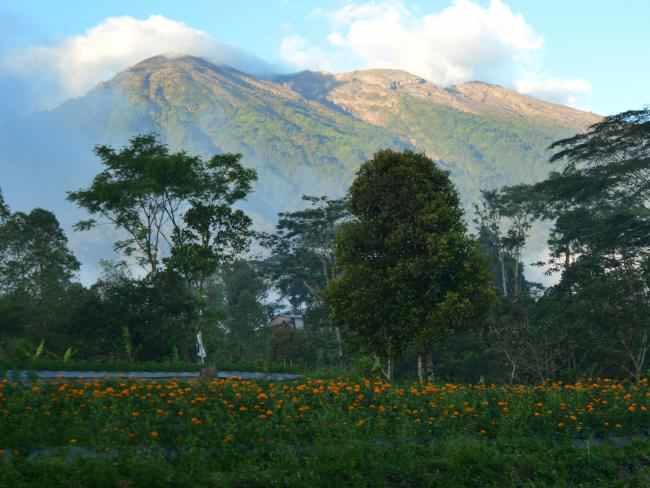
© AFPBali's Mount Agung
Tourists on the Indonesian island of Bali are becoming understandably anxious after Indonesian authorities raised the alert level for the Mount Agung volcano to the highest level.
Some 10,000 villagers have already left their homes around the mountain, while more than 200,000 have received warnings. Locals have described the volcano as "starting to spit".
"Of course it's going to explode," one man said from a rice field overlooking Mount Agung.
Meanwhile, holiday-makers have been urged to be vigilant amid fears of increasing seismic activity and the possibility of a volcanic eruption.
The volcano, about 72 kilometres from the resort area of Kuta, is a popular tourist destination and hiking spot. The National Disaster Mitigation Agency earlier said no residents or tourists should be within 9km of the crater and within 12km to the north, north-east, south-east and south-southwest.
Locals and tourists alike have already begun posting about feeling earthquakes and tremors from deep below the ground as Indonesian authorities sweep a 12km radius from the peak, ensuring no residents or tourists remain in the critical-risk region.
In recent days the Rendang volcano monitoring station recorded 500 tremors in just one day, with one photojournalist describing inhabitants of Sebudi, a nearby province, "packing as many of their belongings as they can".
"The villagers of Temukus felt quakes throughout the night and evacuated at one o'clock in the morning," Rio Helmi wrote.
Helmi said that although the area felt lots of volcanic activity, geologists are concerned over a "lull" in the last few hours, which he said was "not necessarily a good thing".
The evacuation of locals is a telling warning for tourists, with one British woman, Sammy Arkinstall, posting: "I'm too young to die".
Ms Arkinstall's post was just one among a host from tourists who are either in the region already or supposed to be travelling there in coming days and believe their life could be on the line.
Meanwhile numerous tourists, including Australian Dom Koudsi, have posted on Twitter airing their concerns over what to expect next.
"There would be urgent volcano warnings while I'm in Bali for the first time ... heart goes out to evacuees and fingers crossed I make it out," Ms Koudsi wrote.
Playboy playmate Tiffany Toth posted she was "not so happy" about a volcano possibly erupting during her stay in Bali
Fans of the Miss September 2011 Playboy model have been sending her well-wishes and hoping for her safe return.
Despite the anxiety, flights at Bali's international airport are operating as usual and there is little disruption to tourism operators across the rest of the Indonesian island. Airlines including Qantas are monitoring the situation.
The Australian Department of Foreign Affairs issued an updated travel warning for Indonesia that said an eruption could impact air travel in the region.
"Contact your airline or tour operator to confirm travel plans," it said.
"Monitor local media reports and follow the instructions of local authorities. An eruption of Mount Agung could impact air travel in the region".
Phil Sylvester from Travel Insurance Direct told news.com.au the most likely thing that could impact tourists' trips were volcanic ash clouds.
"Two years ago, there were volcanoes that blew ash clouds which meant that airspace over Denpasar was closed so people were stranded in Bali. That is mainly the type of thing that could happen. I don't think people should be particularly worried about being the victim of a volcanic eruption but they very well may be victims of interruption to transport."
Indonesia's volcano monitoring body, MAGMA, warns Mount Agung's eruptions are characteristically explosive and effusive - resulting in deadly pyroclastic flows of ash, rock and lava.
"In case of eruption, the potential primary hazard that may occur within a radius of 9km is pyroclastic fall of size equal to or greater than 6cm," its website on Agung reads.
But its modelling for some of the terrain around the volcano also shows such flows could cover 10km in less than three minutes.
"If an eruption occurs, there is considerable disaster potential," it warns. "People around Mount Agung also do not have enough experience to face the eruption because this volcano last erupted ... 54 years ago."
Agung last erupted in 1963, unleashing deadly pyroclastic flows which killed about 1100 people and hurling ash as high as 10 kilometres. It is just one of 130 active volcanoes in Indonesia, part of the Pacific "Ring of Fire" convergence of tectonic plates.Additional reporting by Associated Press
Reader Comments
to our Newsletter